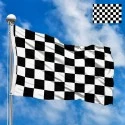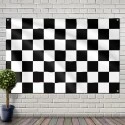- All Flags
- Flags of Countries by Continent
-
Flags of Organizations
- Flags of UN countries
- Flags of the European Union countries
- Flags of NATO countries
- Flags of the countries of the Organization of Islamic Cooperation
- Flags of the countries of the Organization of American States
- Flags of the Arab League countries
- Flags of the African Union countries
- Flags of the countries of the Union of South American Nations
- Flags of the Commonwealth of Nations
- Flags of the countries of the Secretariat of the Pacific Community
- Flags of the Nordic Council countries
- Flags of the Caribbean Community
- Flags of the countries of the Association of Southeast Asian Nations
- Flags of the East African Community
- Flags of the countries of the Organization of Turkic States
- LGBT Community Flags
- Historical Flags
- Ethnic Flags
- Flags of the USA (states)
Description
The checkered black-and-white flag is perhaps the most universally recognized symbol of victory, competition, and the conclusion of a race. This iconic banner transcends language and borders, instantly communicating the end of a long, hard-fought battle and the crowning of a champion. Far more than just a piece of fabric, it is the visual crescendo of speed, skill, and strategy, an emblem of ultimate success in the world of motorsport and beyond.
Design and Symbolism
The design is deceptively simple but incredibly effective. The flag is a field of alternating black and white squares, arranged in a grid-like pattern.
-
The Checkered Pattern: The high-contrast, geometric pattern of the checkered flag is its most defining feature. This design choice was deliberate: the stark contrast of black and white squares ensures maximum visibility, allowing drivers, officials, and spectators to easily identify the flag even at high speeds and from a great distance.
-
Symbolism of Victory and Completion: The checkered flag’s meaning is unambiguous. It is the final signal, the ultimate reward. It symbolizes the successful conclusion of a race, marking the moment a competitor crosses the finish line. For the winner, it is the embodiment of their triumph, a testament to their speed, endurance, and flawless execution. For all other competitors, it signifies that the race is over, and their efforts, regardless of the outcome, are complete.
History of Creation and Adoption
The exact origin of the checkered flag is a subject of historical debate, but its widespread use began in the early days of automobile racing. One popular theory suggests its roots lie in late 19th-century bicycle or horse races, where a checkered tablecloth or similar patterned flag was used to signal the end of the event. A more concrete account links its first documented use to the 1906 Vanderbilt Cup race in the United States. While early forms of flags varied, the use of a checkered pattern quickly became the standard because of its high visibility. Its adoption was not a single, instantaneous event but a gradual process. Over the following decades, as motorsport grew in popularity, the checkered flag became the universally accepted symbol for the end of a race, a tradition that was solidified in the rulebooks of racing organizations worldwide.
Flag Size and Proportions
There is no single international standard for the dimensions of a checkered flag, as its size is often determined by the specific racing series and venue to ensure optimal visibility. However, most flags used in professional motorsport adhere to a proportion of approximately 2:3 or 3:5. The size of the individual squares is also critical; they must be large enough to remain distinct from a distance. A typical flag might have a grid of 8x8 or 10x10 squares, with each square measuring around 15 to 20 cm. The focus is always on creating a visual signal that is impossible to miss.
The Flag and its Meaning for Racers and Fans
For a professional racing driver, seeing the checkered flag is the ultimate emotional moment. It represents the culmination of hours, days, and years of preparation, training, and risk. For the winner, it is an unparalleled feeling of triumph, the relief of a challenge conquered. For the entire team, the flag validates their collective effort—the engineers, mechanics, and strategists whose work behind the scenes made the victory possible. For the spectators, the waving of the checkered flag is the thrilling climax of the event. It is the moment the narrative of the race is resolved, the victor is crowned, and the drama of the competition concludes.
Interesting Facts
-
The checkered flag has a dual purpose. While it signals the end of a race, it is also sometimes used at the start of a race to signal that the pace car is leaving the track, allowing the race to begin.
-
In some forms of racing, such as IndyCar, the winner is also presented with a separate, commemorative checkered flag to keep as a trophy.
-
The flag’s iconic status extends far beyond racing. It is a widely used cultural symbol representing victory, speed, and competition in advertising, fashion, and media.
-
Contrary to popular belief, the flag is not waved at a uniform speed. It is often waved vigorously and quickly for the winner, and then less so for subsequent finishers, a tradition that adds to the spectacle.
-
In some cases, the flag can be waved prematurely due to an official error, leading to controversy and confusion over the final race results. This is an extremely rare but memorable event in racing history.
Ultimately, the checkered flag is a timeless symbol that perfectly encapsulates the essence of competitive spirit—the journey, the struggle, and the glorious moment of triumph at the finish line.
In the demonstration images, full-size flags are shown with proportions of 2:3, and hand-held flags with proportions of 1:2.
Donation
Download
Completely free for commercial and non-commercial use (public domain).
You can freely use them in your news magazines, websites, software, mobile applications.
We appreciate a backlink to https://flagssite.com
Raster files - Checkered flag black and white flag - finish - end of race (PNG, JPG)
 Waving flag
Waving flag
- PNG format (transparent background), 72dpi, dimensions in Pixels (px), aspect ratio 3:4.
- 15х20 px
- 30х40 px
- 60х80 px
- 120x160 px
- 240x320 px
 Sizes:
Sizes:
"v15" - image size (by height); if necessary, replace with available: v15, v30, v60, v120, v240.
!!! For resizing, use the Latin (eng) keyboard layout.
<img src="https://flagssite.com/flags/v15/20911.png" alt="Checkered flag black and white flag - finish - end of race">
 Round flag
Round flag
- PNG format (transparent background), 72dpi, dimensions in Pixels (px), aspect ratio 1:1.
"d15" - image size (diameter); if necessary, replace with available: d15, d30, d60, d120, d240.
!!! For resizing, use the Latin (eng) keyboard layout.
<img src="https://flagssite.com/flags/d15/20911.png" alt="Checkered flag black and white flag - finish - end of race">
 Rectangular flag 2:3
Rectangular flag 2:3
- JPG format, 72dpi, dimensions in Pixels (px), aspect ratio 2:3.
"h30" - image size (by height); if necessary, replace with available: h15, h30, h60, h120, h240, h360, h480.
!!! For resizing, use the Latin (eng) keyboard layout.
<img src="https://flagssite.com/flags/h30/20911.jpg" alt="Checkered flag black and white flag - finish - end of race">







 Sizes:
Sizes:
 Sizes:
Sizes: